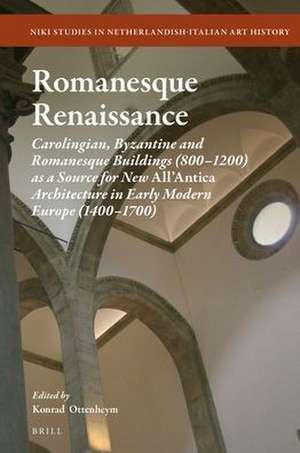Romanesque Renaissance: Carolingian, Byzantine and Romanesque Buildings (800–1200) as a Source for New <i>All’Antica</i> Architecture in Early Modern Europe (1400–1700): NIKI Studies in Netherlandish-Italian Art History, cartea 14
Editat de Konrad Adriaan Ottenheymen Limba Engleză Hardback – 14 ian 2021
Contributors: Barbara Arciszewska, Lex Bosman, Ian Campbell, Eliana Carrara, Bianca de Divitiis, Krista De Jonge, Emanuela Ferretti, Emanuela Garofalo, Stefaan Grieten, Hubertus Günther, Stephan Hoppe, Sanne Maekelberg, Kristoffer Neville, Marco Rosario Nobile, Konrad Ottenheym, Stefano Piazza, and Richard Schofield.
Preț: 882.35 lei
Preț vechi: 1076.03 lei
-18% Nou
Puncte Express: 1324
Preț estimativ în valută:
168.89€ • 183.51$ • 141.96£
168.89€ • 183.51$ • 141.96£
Carte indisponibilă temporar
Doresc să fiu notificat când acest titlu va fi disponibil:
Se trimite...
Preluare comenzi: 021 569.72.76
Specificații
ISBN-13: 9789004446618
ISBN-10: 9004446613
Dimensiuni: 155 x 235 mm
Greutate: 0 kg
Editura: Brill
Colecția Brill
Seria NIKI Studies in Netherlandish-Italian Art History
ISBN-10: 9004446613
Dimensiuni: 155 x 235 mm
Greutate: 0 kg
Editura: Brill
Colecția Brill
Seria NIKI Studies in Netherlandish-Italian Art History
Cuprins
Preface
Michael Kwakkelstein
List of Illustrations
Notes on Contributors
Romanesque Renaissance – Introduction
Konrad Ottenheym
1 Il ruolo della memoria normanna nella cultura architettonica siciliana della prima età moderna
Stefano Piazza
2 Tra mito e modello. Le cattedrali normanne nell’architettura Religiosa del Cinquecento in Italia meridionale
Emanuela Garofalo
3 Le cupole in pietra a vista nel primo Cinquecento in Sicilia
Marco Rosario Nobile
4 Memory of the Romanesque in Renaissance Southern Italy: From Paper to Stone
Bianca de Divitiis
5 The Scottish Romanesque Revival Revisited (Again)
Ian Campbell
6 Polish Architecture ‘more vetusto … murata’: References to Romanesque Buildings in the Polish-Lithuanian Commonwealth before 1600
Barbara Arciszewska
7 Romanesque Reconstructions: The Revival of Liège in the Early Sixteenth Century
Stefaan Grieten and Krista De Jonge
8 Matters of Representation: On the Revival of the Early Mediaeval Keep in Brabant during the Early Modern Period
Krista De Jonge and Sanne Maekelberg
9 A Deconstruction of San Michele in Isola in Venice
Richard Schofield
10 Il Battistero di Firenze nella storiografia medicea tra Cosimo I e Francesco I
Eliana Carrara and Emanuela Ferretti
11 Byzantine Cupolas and the Myth of the ‘Ancient Origins’ of Venice
Hubertus Günther
12 Architecture and Early Humanism at German Princely Courts: Lower Bavaria, Salzburg and Passau and the Romanesque Renaissance (c. 1480–1500)
Stephan Hoppe
13 The ‘Pagan Chapel’: St Nicolas’ Chapel at Nijmegen and Other Romanesque Rotundas Regarded as Ancient Temples
Konrad Ottenheym
14 Roman or Romanesque? Confusion about the Putative Temple of Apollo in Maastricht
Lex Bosman
15 Text and Form: The Beginnings of Architectural History and Architectural Aesthetics in the Far North
Kristoffer Neville
Index
Michael Kwakkelstein
List of Illustrations
Notes on Contributors
Romanesque Renaissance – Introduction
Konrad Ottenheym
Part 1: Romanesque Architecture and the Venerable Past of the Church and the Realm
1 Il ruolo della memoria normanna nella cultura architettonica siciliana della prima età moderna
Stefano Piazza
2 Tra mito e modello. Le cattedrali normanne nell’architettura Religiosa del Cinquecento in Italia meridionale
Emanuela Garofalo
3 Le cupole in pietra a vista nel primo Cinquecento in Sicilia
Marco Rosario Nobile
4 Memory of the Romanesque in Renaissance Southern Italy: From Paper to Stone
Bianca de Divitiis
5 The Scottish Romanesque Revival Revisited (Again)
Ian Campbell
6 Polish Architecture ‘more vetusto … murata’: References to Romanesque Buildings in the Polish-Lithuanian Commonwealth before 1600
Barbara Arciszewska
7 Romanesque Reconstructions: The Revival of Liège in the Early Sixteenth Century
Stefaan Grieten and Krista De Jonge
8 Matters of Representation: On the Revival of the Early Mediaeval Keep in Brabant during the Early Modern Period
Krista De Jonge and Sanne Maekelberg
9 A Deconstruction of San Michele in Isola in Venice
Richard Schofield
Part 2: Romanesque Architecture as Imaginary Antiquity
10 Il Battistero di Firenze nella storiografia medicea tra Cosimo I e Francesco I
Eliana Carrara and Emanuela Ferretti
11 Byzantine Cupolas and the Myth of the ‘Ancient Origins’ of Venice
Hubertus Günther
12 Architecture and Early Humanism at German Princely Courts: Lower Bavaria, Salzburg and Passau and the Romanesque Renaissance (c. 1480–1500)
Stephan Hoppe
13 The ‘Pagan Chapel’: St Nicolas’ Chapel at Nijmegen and Other Romanesque Rotundas Regarded as Ancient Temples
Konrad Ottenheym
14 Roman or Romanesque? Confusion about the Putative Temple of Apollo in Maastricht
Lex Bosman
15 Text and Form: The Beginnings of Architectural History and Architectural Aesthetics in the Far North
Kristoffer Neville
Index
Notă biografică
Konrad Ottenheym is Professor of Architectural History at Utrecht University (The Netherlands). His publications deal with Dutch architecture and architectural theory of the early modern period with a special focus on its relationships with other European regions.



